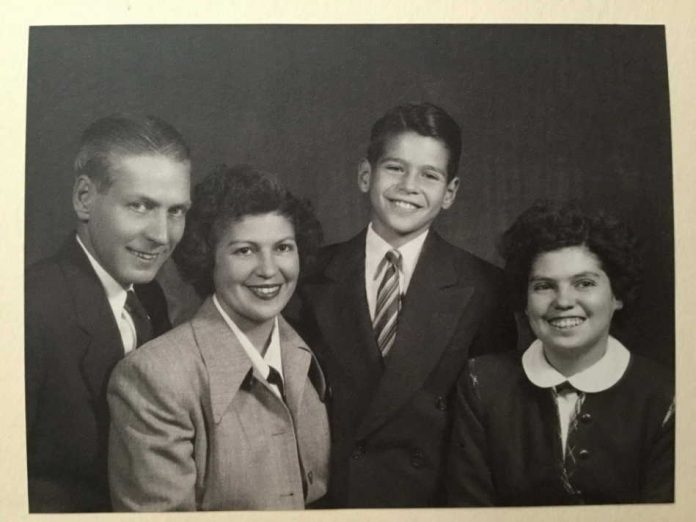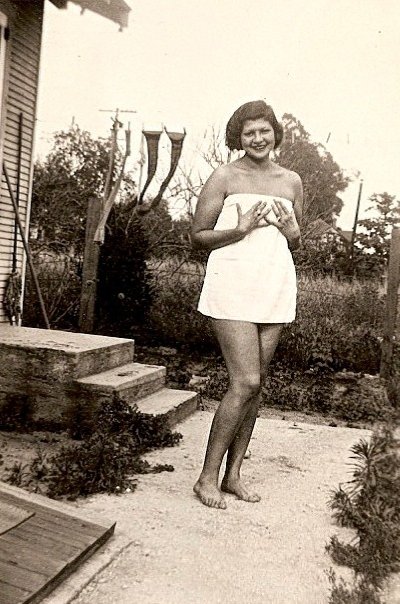
This article was generously funded by the Aztlán Journalism Fund — gracias, anonymous donor!
His name was Zip. About the size of a Teddy bear, he was a black monkey wearing a yellow shirt, red overalls, white shoes and a red and white hat. It was around 1984 I think, which means my sister was 10 and I was 12, and for a couple months that year she carried that little monkey everywhere.
One Sunday, she brought it on our weekly visit to our grandmother, who lived in an old but neat two-bedroom apartment in East Los Angeles, about a block from the majestic old Golden Gate Theater, which in 2012 was redeveloped into a CVS. We were walking back to our car to take Grandma to lunch as we usually did and I was more energetic than usual. I took Zip from my sister and started playing with his hat, which had a floppy brim. I quickly discovered that I could fold the front of his brim up, giving him a Speedy Gonzalez look.
“I’m a Mexican American,” I said in a sing-song voice as we got to the car. “I’m a Mexican American.”
My grandmother immediately (and rightfully) shushed me. “There are people like that around here,” she told me.
I immediately quieted down—even at that age, I understood I had crossed into ugly territory. But there was something else—something about her wording that never left me.
Of the few photos I have of my grandmother, Marguerite Gerhart, my mother’s mother, the most interesting was the surprise find my sister and I made after the death of my father, in 2007, of cancer. We spent two weeks cleaning out everything my parents had owned (our mom had died 13 years prior to that, also of cancer), and had discovered this particular photo in a pile of Mom’s old family photos. Though my grandmother was still alive then–she was living on the East Coast with her son, our uncle—my sister and I had lost touch with her.
The grainy, sepia image apparently dates to 1932—the year was scrawled on the back, the only caption or identifying mark on it. The fact that it’s from 1932 is a big deal—that’s the year Marguerite turned 21, and left her home in Monrovia to return to Tucson, Arizona—her city of birth. In the photo, the woman who 40 years later would become my grandmother is standing in what looks like a backyard—there are stone porch steps nearby, shrubs on the ground, a clothesline in the back ground and what looks like dirt or gravel under her bare feet.
It’s hard to tell if the photo was taken in Tucson or Monrovia. There are stockings hanging on the clothesline and a white towel loosely draped around Marguerite. It’s all she’s wearing, in fact.
Her smile is more playful than sexual, even though her hands are pressed against her chest, holding up the towel. I don’t know who snapped the photo, or why it was taken. Recently I looked at my digital copy of it and noticed something else about I hadn’t thought of before—her skin tone. It’s tanned, or looks tanned, and is nearly brown. I looked at her limbs, her face, her thick hair that’s darker than the stockings hanging just behind her, and a thought occurred to me: she looks like a Mexican American. And then, a second later, I wondered something I should have thought many years ago: was my grandmother, who I always thought of as a white woman, actually white?
It’s not a trivial question, coming at time of heightened racism throughout the nation. Even Tom Brokaw, who spent so many decades anchoring the NBC Evening News, got into the act in 2019 with his call for Latino people to do better at assimilation. He later apologized, but the notion that Latino people don’t or didn’t assimilate into the U.S. is horribly ignorant.
“[A]ssimilation wasn’t always a choice,” Maria Cardona, a principal at the Dewey Square Group, a Democratic strategist and a CNN/CNN Español political commentator, wrote in a January 2019 op-ed in The Hill. “There is a whole generation of Latinos who grew up in the 1950s and 60s in the Southwest, who were beaten or scolded and who were discriminated against if they spoke Spanish in school or in public. As such, their Mexican immigrant parents made them speak only English, even at home. As a result, and to their chagrin today, they lost their native language and assimilated almost by force to survive.”
My grandmother unquestionably identified as white. Her interaction with me over my sister’s monkey doll showed that. Unlike someone like the actress Alexis Bledel (Rory from The Gilmore Girls) who ostensibly looks East Coast white but is actually Mexican and Argentinian and grew up speaking Spanish, my grandmother eschewed most everything cultural that wasn’t Yankee American.
I don’t recall her ever speaking or understanding Spanish, following news from Latin America, watching Spanish-language television or making Mexican food (indeed, she was of the generation that called Mexican rice “Spanish rice”). She loved white big band swing music from the 1930s and ‘40s—I still remember seeing Glenn Miller albums in her apartment, which she’d play on a huge, ancient cabinet that held a record player, AM/FM radio and speakers. She called the department store chain Montgomery Ward “Monkey Ward.” Indeed, she was the type of conservative who considered herself, and I remember this vividly, to be ethnically “American”—a confusing of social position with ethnicity that I’ve seen many white people do.
Society thought, and would still think, that her mother, born Maria Vasquez but later known as Mary, was Latina. Anyone who saw Mary’s ad that ran in the Monrovia News-Post in 1931 for “Tamales made by special order” would have thought that. This wasn’t surprising, given that Mary’s mother had been born in Sonora, Mexico. The 1910 census placed Mary and her family squarely in a Mexican barrio in Tucson.
This was a dangerous time for Mexican Americans in the United States. Also in 1910, a proposition passed at the Arizona Constitutional Convention banning “aliens” from all public works projects. Four years later, state voters overwhelming passed a proposition that would prohibit individuals and corporations from “employ[ing] alien labor to the extent of more than twenty per cent of the entire amount of labor employed” by that individual or corporation.
I thought back to that elementary school project we all had to do where we interview our grandparents. Gerhart was of course her married name—her husband, a mostly German American man from Michigan, had died in 1949, but she kept his name and never remarried. Her maiden name, she told 10-year-old me, had been Duran. The name was clearly Spanish (every boy in American who grew up in the 1980s knew the name from heavyweight boxer Roberto Duran), but she had told me that her father was Basque—the tiny ethnic group located in the Pyrenees Mountains between Spain and Portugal—though Duran is clearly not a Basque name. Jim Gerhart, my uncle and Marguerite’s only surviving child, remembers much the same thing.
“I recall asking my mother if I was half Mexican,” he told me recently. “She said her mother was Mexican, nee Vasquez, her father, James Duran was Caucasian and came from the Pyrenees and was Spanish.”
I don’t think my grandmother remembered much of her father. And other than his 1910 marriage certificate with Mary Vasquez (Marguerite’s mother), I could locate no public documents or news accounts that were definitely tied to him. He is, as far as I can tell, just a signature on a document. When I was a child, Marguerite told me her father had left the family when she was very young, and I don’t believe she had much of any memory of him. Making matters worse, Marguerite didn’t care for her own mother, either.
“She had a tough childhood,” Jim told me. “Her father left early on, and her mother was a strict person. She made Mom kneel down on rocks and cobblestone pebbles until she conformed to whatever the issue was that day.”
The kneeling on rocks was unquestionably physical abuse, and I vividly remember my own mother telling me about it, too. I know my grandmother never forgot it, because neither my mom—JoAnn—nor her brother Jim ever complained about similar treatment from their mom.
While researching this story, I discovered Marguerite’s childhood was even tougher than I knew. In 1919, when she was eight, Mike Silvas—her 28-year-old step-father, who had married Mary Vasquez in 1916—tried to kill himself. To show what small town news was like a century ago, the attempt made the front page of the Monrovia Daily News, which included details of how he tried to kill himself. “Domestic unhappiness is declared to be the cause of Silvas’s act,” the paper added for no other reason than cheap sensationalism, for all his neighbors and friends to see.
At the time of the attempt, Silvas had a step-kid who was physically abused by her own mother, a two-year-old son, a one-year-old daughter, and another child on the way. Silvas must have gotten some sort of help, because he eventually lived to be 77. If Marguerite even knew of his suicide attempt, or what specifically might have led to it, she never mentioned it to me.
*

It wasn’t until I started looking into her past that I discovered that Marguerite was not her birth name. Like her mother, who Americanized her name from Maria to Mary, Marguerite decided at a young age that she didn’t want to be known by her given name.
She was born Margarita Duran, on Feb. 24, 1911 in Tucson, then located in the Territory of Arizona, to parents who’d gotten married about nine months prior. By 1911, the Apaches who originally ranged over what we now call Tucson were mostly gone, replaced by a large Mexican population and fast-growing numbers of white Americans. It was also largely segregated, with whites “firmly in control of the central business district,” according to Thomas E. Sheridan’s 1986 book Los Tusconenses: The Mexican Community in Tucson, 1854-1941. In the late 19th century, “Mexicans were rarely allowed to serve on juries,” Sheridan wrote. “Spanish-surnamed criminals were treated more severely than their Anglo counterparts.” Though Mexican Americans would hold a number of powerful political and law enforcement posts at the time of Marguerite’s birth, the growing Anglo population meant times would change rapidly.
“Mexicans no longer constituted a majority of Tucson’s population [by 1911], and so they witnessed an ever-increasing erosion of their leverage in both the Democratic and Republican parties,” Sheridan wrote. “[D]espite the hard-won gains of the Mexican middle class, most Mexicans lived and labored in a world of barrios and blue-collar jobs… prevented by discriminatory hiring practices, language barriers, and a lack of educational opportunities from moving up the occupational ladder.”
I know very little about my grandmother’s childhood in Arizona, except that it was brief. From what I could glean from 1910 census records, she was almost certainly raised in the Mexican part of time near the old “Indian School,” which is today part of the University of Arizona. In 1916, her mother—by that point calling herself Mary—married a man named Mike Silvas in Southern California.
In any case, Marguerite had a new family now. Now living in Monrovia, her mother sent her to parochial schools, including Immaculate Conception Catholic School. Despite the trouble and abuse at home, my memory is that Marguerite (who as a child went by “Margie”) was a good, active student. A Monrovia News-Post article from 1929 lists her as a Glee Club member at Monrovia High.
Though she was in Monrovia during the 1918-1919 influenza pandemic, my grandmother never spoke of it. Perhaps she was simply too young to recognize the trauma at the time, though articles from the Monrovia Daily News published in October 1918 make clear that city health officials shut down nearly every public gathering place in a bid to stop transmission.
Jim Gerhart also told me his mom never talked about her childhood neighborhood. At the time, Monrovia was just as racially segregated as Tucson. The 1920 and 1930 census show Marguerite living on Almond Avenue and Chestnut Avenue, respectively—both locations right in the middle of the part of town restricted to Black, Asian and Mexican American families, according to Pasadena City College history professor Susie Ling.
“It was in the 1910s that the African Americans and Mexican Americans of Monrovia became segregated south of the tracks,” Ling wrote on her Thinking Aloud blog in 2015. “Housing was restricted between Myrtle and Shamrock, and south of the Pacific Electric tracks (built 1903) on Olive Avenue.” By the 1920s, “Almond Ave. was the main residential street of the early Mexican American community,” Ling wrote in another 2015 blog post.
Census takers back then wrote fascinating things in their notebooks. For instance, in 1920, the taker listed Spanish as the native language for everyone in the Silvas household. And in 1930, in the column for ethnicity, the taker wrote “neg”—negro—for every member of the Silvas family. It’s possible to read too much into such notations (the 1940 census taker did list all their ethnicities as “white”) but then again, the census can be a marvelous example of how fluid “whiteness” can be. This was well illustrated by the 1910 census, where the census taker wrote “Mex” next the address of Maria Vasquez’s house, but listed everyone in the house as being “white.”
In the third year of the Great Depression, Marguerite turned 21. She was now a hair stylist and manicurist. A few months later, she decided to move back to Tucson. I know this because the Monrovia News-Post wrote about it.
“Miss Marguerite Duran who has been an operator at the Marinello Beauty Shop for the past two years left for Arizona Saturday morning and Friday evening a farewell party was given in her honor by a group of friends,” the paper reported on Aug. 8, 1932 in a fine example of how hyper-local news coverage is anything but new. “The girls spent the evening riding, a popular pastime with them and a weinie [sic] bake, which was a complete surprise, was given by the Golden West Riding Academy after the ride, and with the help of more refreshments, which had been planned at the home of Miss Gertude Tillford, the evening was a most enjoyable one.”
But the most interesting part of the party story was how it showed just how integrated Marguerite had become into Monrovia’s Anglo society—the story ended with a list of her attendant friends, friends with WASPy names like Tillford, Phillips, Gibson, Lawton. But just four months later, Maguerite’s social circles changed dramatically. At the end of the year, she held an “informal dancing party,” and got the Arizona Daily Star to run a brief article on it on Dec. 7, 1932. With just a couple exceptions, the 51 attendees all had Spanish names like Ramirez, Peralta, Camacho, Robles, Salgado.
I don’t know what Marguerite’s future would have been had she stayed in Monrovia. All I know is once she was back in Tucson, she got a job at the fancy, high-priced El Conquistador Hotel. Even in the early, awful years of the Great Depression, rich people were still rich people. There, she got to know one particularly rich and powerful white man at the hotel.
He was General of the Armies John Joseph Pershing, then one of the most famous military figures in the world. Before he commanded the American army during the Great War, he had led troops into Mexico in 1916. Publicly, President Woodrow Wilson said Pershing’s men would capture the revolutionary Pancho Villa, but privately he told the general merely to disperse Villa’s forces. While Pershing failed in the former, he did succeed in the later, though his “victory” came at the cost of allowing Mexican leader Venustiano Carranza to solidify his position and stoke anti-American sentiment, according to historian James Sandos.
By the 1930s, the retired Pershing was wintering in Tucson, usually at the El Conquistador, historian John T. Greenwood wrote in his introduction to Pershing’s memoirs. Long out of power, he was still a figure of immense public stature. And according to my grandmother, she—a Latina in her early 20s—often filed his nails and clipped his cuticles. “He had beautiful hands,” I remember her saying. I don’t believe anything romantic happened between them, though judging by the number of times my grandmother repeated this story to her children and grandchildren, the general certainly made an impression on her.
Then sometime in 1933 or early 1934—I don’t know exactly when—Marguerite met Frank Kelsey Gerhart. Born to German American parents in Michigan with a heart defect that would kill him at the age of 40, Gerhart trained as an architect, but may have been working as an engineer when he met Marguerite—a consequence of his having to take any available work during the Great Depression. I don’t recall if anyone ever told me how they met, and my uncle no longer recalls, but on May 31, 1934 they were married.
Gerhart had both a beautifully steady hand—one of his sketches, of an adobe house he titled “Mexican quarter: Tucson, Arizona” still hangs in my apartment today—and a hot temper. In fact, I’m alive because of his inability to handle anger in a responsible manner. The birth of his first child JoAnn (my mother) in 1936 was difficult, and the doctor pronounced the baby dead. But Frank—according to Marguerite—grabbed the doctor and shoved him against a wall. “No, she’s alive,” he told her. “Now go back there and save her and my wife.” The doctor, shaken, did as he was told, and succeeded in reviving JoAnn.
Three years later, Marguerite gave birth to a son, Frank James (my uncle Jim). First living in Michigan, the family eventually moved west, to Los Angeles. Life was happy, then it wasn’t. In 1949, Frank died, leaving Marguerite, now aged 38, a single mother of two.
*
If you somehow find a copy of the 1987 TV movie Hollow Point (also sometimes titled In Self Defense), and you skip about an hour and 15 minutes into the picture, you’ll see star Linda Purl following baddie Billy Drago through an outdoor market. If you look carefully at first the sunglasses stand and later the tent selling prints and lithographs, you’ll see a slim woman with silver hair in blue in the background. That’s Marguerite, my grandmother.
When I knew my grandmother, she was a vibrant woman with a comforting smile. Every day she drank a “milkshake” of her own concoction: yogurt, various fruits, wheat germ and other vitamins. She often went for walks, usually at malls like Pasadena and later Montebello. Though she smoked for many years, she suddenly stopped sometime in the 1980s. And that was it—she never went back. Quitting smoking was, like so much of her life, simply a matter of powering through it, on her own.
She also, being retired, wanted to keep busy. So for a time in the late 1980s she worked as a Hollywood extra, though other than Hollow Point I’m not sure she appeared in much (though she apparently did get a number of calls asking her to appear in adult films, which thoroughly entertained her).
She was living in a two-bedroom apartment in East Los Angeles. Until the early 1980s, she was living with her aunt, Pauline Nardelli, who by then was suffering from dementia. Pauline was of a generation that probably saw more technological advancement than any other in history—born at a time of steam engines, telegraphs and covered wagons, she would eventually see the introductions of television, internal combustion engines, powered flight, jet engines, spacecraft, microcomputers, artificial hearts, robotics, lasers and nuclear weapons.
A sister of Mary Vasquez, Pauline was as kind as Mary was cruel. A dry cleaner and fancy presser by trade, she had married an Italian American miner and laborer named Anthony John Nardelli back in 1913. Nardelli had died in 1944, so after Frank’s death Marguerite—who needed to go back to work as a hair-dresser—asked Pauline to come live with her, which she did. The widow Pauline would remain with the widow Marguerite for more than 40 years. Neither ever married again.
“She, who I called ‘Auntie,’ essentially raised us while my mom worked,” Jim recalled. “Pauline did the day-to-day cooking while my mom and sister were at work.”
While that happened, Jim remembered, his mom cajoled men she knew into giving her son training—apprentice carpentry, things like that—so that he would still have male mentors in his life. “That was very important to her,” Jim said. “She didn’t want me to be a mama’s boy.”
Politically, my grandmother was very conservative. I don’t know if it stemmed from her pious Catholic upbringing, or grew after her marriage (Frank Gerhart was apparently also conservative, and both of children became conservative). Maybe it was helped by the years she spent as a small business owner (eventually, her MarJo Beauty Shop in Monterey Park was a joint venture run by her and my mother, who also went into hair-dressing as a career).
Once, when my mom mentioned the Zoot Suit Riots of 1943 while talking over local history with my grandmother and I asked what had happened, they described them in such a way that made it pretty clear to me, even at that age, that they thought the Navy instigators were the real victims. This isn’t surprising to me, given that in the 1980s, Marguerite was a subscriber of The Spotlight, a far-right newsletter published by the now-defunct Liberty Lobby. She watched the news on TV every night (national and local), read a variety of books and kept up with politics and current events. I even recall her telling my mom in 1988 that Donald Trump was considering a presidential run.
Though not a feminist, her independence, intellect and complete willingness to speak her mind were a powerful feminist influence on pre-teen me. Her mere presence in my life was indelible evidence that women were not only equal to men in every manner, but deserved everything men received, including—perhaps most importantly—the right to have the benefit of the doubt.
Her attitude towards traveling also conflicted with her traditional conservative views. In the 1960s, after her children had grown, Marguerite took a series of trips to Europe. Sometimes she was by herself, other times as a companion for a woman named Betty Bahnsen, who along with her husband Eigil owned a massive duck farm in El Monte. Bahnsen had cancer and didn’t really care about niceties (in the 1980s, after Bahnsen died, my grandmother worked as a kind of in-home caregiver for Eigil). Through it all, Marguerite traveled not as an ideologue, but as a genuine student of foreign cultures and traditions. Always a friend to service industry workers—something she learned back in the 1930s in Tucson’s hotels—she went out of her way to leave as small a footprint as possible in her travels, though that wasn’t always possible.
She was in Europe in late November 1963, and was shocked to hear that President John F. Kennedy had been murdered. She was at a restaurant or some other establishment with a television set, and the very conservative couple next to her snorted at the news, then made some derogatory comment about the Kennedy women always having kids. This appalled my grandmother, who dressed them down for denigrating the President of the United States in a foreign country. She may not have agreed with Kennedy’s policies, but the thought of Americans ridiculing American leaders overseas really got to her.
“They were ‘ugly Americans,’” she told my sister and I, using a phrase made famous in the 1958 novel of the same name by Eugene Burdick and William Lederer. She often talked of the “ugly Americans” she saw overseas—tourists who were rude to the locals, or refused to even attempt to learn phrases of the local language. These were usually the bad guys in her stories. They infuriated her, who took very seriously the idea that she was a guest in a foreign country, and did all she could to behave with dignity and respect. Well, mostly.
I believe she was in France when she started a political conversation with a hotel doorman. Eventually, out of naivete or simply a dry sense of humor, she asked him if he was a communist. “He clicked his heals and straightened up,” my grandmother recalled to me, “and said he was.” It was during that trip, she later recalled, that someone warned her to start marking her luggage placement with tape before she left her room, which she did. Sure enough, one night she returned and found someone had entered her room and searched her bags.
My grandmother understood the role luck played in her travels, and respected it. During another trip, I believe through Italy, malicious American tourists had given her and her friend the address for an “authentic local restaurant.” Their cab driver, looking at the address, told them in broken English that he shouldn’t take them there, but my grandmother insisted. He finally relented, and drove off into the Italian countryside. At their destination, they found to their horror that they were in a bordello.
As the men inside began pointing at them, the two women raced outside. Thankfully, their cabby hadn’t left. “Why didn’t you tell us?” my grandmother asked when they were back inside the car. “I didn’t know the words,” he said, apologetically. She then wrote out three phrases for him for use in the future, depending on the fare: “house of ill repute” if they were rich, “house of prostitution” if they were middle class, and “whorehouse” if they didn’t look to be in the first two groups.
*
If my genealogical research is correct, Mary Silvas—Marguerite’s mother, and my great grandmother—died in Monterey Park in 1985 at the age of 98. Monterey Park is relatively close to East Los Angeles, and it’s odd for me now to think about visiting my grandmother as a boy and not knowing I still had an even older relative a few miles away. I have no idea if Marguerite even knew her mother was so close to her back then, but it wouldn’t surprise me to know that she did, and kept it to herself.
When Pauline developed dementia, my grandmother chose to become her in-home caregiver. This worked for a while, but when the physical demand of caring for her became too great, and she put Pauline in a nursing home. In no time at all, Marguerite felt horribly guilty and brought her aunt back home. “I can’t do this,” my grandmother told my uncle of her decision. She just couldn’t bear with the thought of handing Pauline off to others. But eventually the physical needs for providing Pauline care overrode even her sense of personal responsibility, and she once again put Pauline in a home. Pauline, who Jim, my sister and I had always called “Auntie,” died the same year as her sister, at the age of 92.
It didn’t surprise me to hear that my grandmother had outlived even her, finally passing at 99. Marguerite’s grandmother had also lived well into her 90s. “It’s because they’re Mexican lol,” a Latina friend texted me while I was discussing this story with her.
For about 40 years, I figure, Marguerite lived in a neighborhood close to 100 percent Latino. I remember after one incident where some guy followed my grandmother from her car to her front door, and she was just able to let herself inside before he got too close, my mom asked her to move closer to us in Whittier. She didn’t own a lot of stuff—moving would not have been difficult or terribly expensive. But she didn’t. She stayed put, saying that was where her friends were, until long after my mom had died. In the early 2000s, she finally moved to Virginia to be with her son Jim, his children and grandchildren.
Until I started researching this story, this notion of a nice old white lady living in the middle of East LA, just yards away from Whittier Boulevard, made no sense. Now it makes perfect sense. She had lived in the heavily Latino neighborhood of Monrovia throughout her childhood—there was little difference now, except she wasn’t abused anymore. She almost completely assimilated—acting, thinking and speaking like a white person—which was all too often what “assimilation” meant a century ago.
In the book Los Tucsonenses, Sheridan quotes Stanford School of Education Dean Ellwood P. Cubberley as saying in 1909 (just two years before my grandmother’s birth) that “Our task is to assimilate and amalgamate these people as a part of our American race, and to implant in their children, so far as can be done, the Anglo-Saxon conception of righteousness, law and order… and to awaken in them a reverence for our democratic institutions.”
My grandmother was born in U.S. territory, to a woman who’d been born in U.S. territory, but neither was very far removed from Mexico. Sure, they Americanized their names, but both also maintained at least some ties to Mexico—even if they didn’t realize they were doing it. Mary selling tamales during the Great Depression as certainly one example, and I like to think Marguerite living for nearly four decades in a majority Latino neighborhood was another.
But more than that, I can’t help but think my grandmother othered her own heritage in an attempt to become “more American.” And that makes me wonder how my outlook on racism and whiteness would have changed if, in response to my dumb joking as a child, she had said that she herself was a Mexican American.
Anthony Pignataro is an investigative reporter and editor for the Long Beach Post. He has close to three decades of experience in journalism leading numerous investigations and long-form journalism projects for the OC Weekly and other publications. He joined the Post in May 2021.









